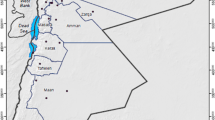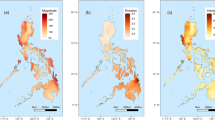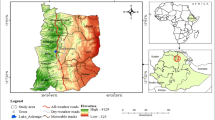Abstract
In Ethiopia, recurrent droughts were associated with El Niño phenomenon, particularly in the study area where the majority of smallholder farmers depend on rain-fed agriculture. The aim of this study was to model the spatio-temporal meteorological drought onset, offset, duration, magnitude, intensity, frequency, severity and spatial extent in Raya and its environs, Northern Ethiopia. Both the ground meteorological stations and TAMSAT (tropical applications of meteorology using satellite and ground-based observations) monthly rainfall data were gathered from the National Meteorological Agency of Ethiopia for the period 1983–2015. The Inverse Distance Weighting (IDW), a type of the deterministic interpolation method was applied to quantify the amount of seasonal rainfall by producing surface rainfall map. A Standardized Precipitation Index (SPI) at 3-month timescale was used to evaluate seasonal rainfall deficit and characterize meteorological drought. The results revealed that all sites obtained minimal and irregular rainfall, hence led to catastrophic droughts. Also, the findings showed that there was high rainfall variability across the study area that ranged from 28.14 to 42.32%. As a result, mild-to-severe meteorological drought phenomena were observed once in every 2–3 years. This incidence was found to be high in terms of spatial and temporal coverage during the last three decades. Therefore, this study may help to offer better insight for policymakers to establish drought mitigation and adaptation strategies.
Similar content being viewed by others
References
Abebe BA (2014) Modeling the Effect of Climate and Land Use Change on the Water Resource in Northern Ethiopia (Doctoral dissertation, Freie Universität Berlin)
AghaKouchak A, Farahmand A, Melton FS, Teixeira J, Anderson MC, Wardlow BD, Hain CR (2015) Remote sensing of drought: progress, challenges and opportunities. Rev Geophys 53(2):452–480
Alemayehu A, Bewket W (2016) Local climate variability and crop production in the central highlands of Ethiopia. Environ Dev 19:36–48
Assefaw T (1993) Participatory relief management: the experience of the relief society of tigray. Refug Can J Refug 12(8):23–25
Awulachew SB, Yilma AD, Loulseged M, Loiskandl W, Ayana M, Alamirew T (2007) Water resources and irrigation development in Ethiopia, vol 123. Iwmi, Colombo
Ayenew T, GebreEgziabher M, Kebede S, Mamo S (2013) Integrated assessment of hydrogeology and water quality for groundwater-based irrigation development in the Raya Valley, northern Ethiopia. Water Int 38(4):480–492
Belal AA, El-Ramady HR, Mohamed ES, Saleh AM (2014) Drought risk assessment using remote sensing and GIS techniques. Arab J Geosci 7(1):35–53
Bonaccorso B, Bordi I, Cancelliere A, Rossi G, Sutera A (2003) Spatial variability of drought: an analysis of the SPI in Sicily. Water Resour Manage 17(4):273–296
Conway D (2000) Some aspects of climate variability in the north east Ethiopian Highlands-Wollo and Tigray. Sinet Ethiop J Sci 23(2):139–161
Gidey E, Dikinya O, Sebego R, Segosebe E, Zenebe A (2017) Modeling the spatio–temporal dynamics and evolution of land use and land cover (1984–2015) using remote sensing and GIS in Raya, Northern Ethiopia. Model Earth Syst Environ 3(4):1285–1301
Gidey E, Dikinya O, Sebego R, Segosebe E, Zenebe A (2018) Predictions of future meteorological drought hazard (~ 2070) under the representative concentration path (RCP) 4.5 climate change scenarios in Raya, Northern Ethiopia. Model Earth Syst Environ. https://doi.org/10.1007/s40808-018-0453-x
Kogan F, Guo W (2016) Early twenty-first-century droughts during the warmest climate. Geomat Nat Hazards Risk 7(1):127–137
Kogan F, Adamenko T, Guo W (2013) Global and regional drought dynamics in the climate warming era. Remote Sens Lett 4(4):364–372
Livada I, Assimakopoulos VD (2007) Spatial and temporal analysis of drought in Greece using the standardized precipitation index (SPI). Theor Appl Climatol 89(3–4):143–153
McKee TB, Doesken NJ, and Kleist J (1993) The relationship of drought frequency and duration to timescales. In Proceedings of the 8th Conference on Applied Climatology. Boston, MA, USA: American Meteorological Society, 17(22):179–183
Mishra AK, Singh VP (2010) A review of drought concepts. J Hydrol 39(1):202–216
Paulo AA, Pereira LS (2006) Drought concepts and characterization: comparing drought indices applied at local and regional scales. Water Int 31(1):37–49
Peters AJ, Walter-Shea EA, Ji L, Vina A, Hayes M, Svoboda MD (2002) Drought monitoring with NDVI–based standardized vegetation index. Photogramm Eng remote Sens 68(1):71–75
Rossi G, Bonaccorso B, Vega T (eds) (2007) Methods and tools for drought analysis and management, vol 62. Springer Science and Business Media, Berlin. ISBN 978-1-4020-5923-0
Şen Z, Al-Harithy S, As-Sefry S, Almazroui M (2017) Aridity and risk calculations in saudi arabian wadis: Wadi Fatimah case. Earth Syst Environ 1(2):26
Shamsipour AA, Zawar-Reza P, Alavi Panah SK, Azizi G (2011) Analysis of drought events for the semi–arid central plains of Iran with satellite and meteorological based indicators. Int J Remote Sens 32(24):9559–9569
Svoboda M, Hayes M, Wood D (2012) Standardized precipitation index user guide. World Meteorological Organization, Geneva
Tabari H, Taye MT, Willems P (2015) Statistical assessment of precipitation trends in the upper Blue Nile River basin. Stoch Env Res Risk Assess 29(7):1751–1761
US National Drought Mitigation Centre (US–NDMC) 2016. The Standardize Precipitation Index. http://www.drought.unl.edu/monitor/spi/program/SPI_Zimbabwe.doc, Accessed on 06/06/2016
Wang PX, Li XW, Gong JY, Song C (2001) Vegetation temperature condition index and its application for drought monitoring. In: Geoscience and Remote Sensing Symposium, 2001. IGARSS’01. IEEE 2001 International. IEEE, 1:141–143
Wilhite DA (1996) A methodology for drought preparedness. Nat Hazards 13(3):229–252
World Bank (2006). Ethiopia: managing water resources to maximize sustainable growth. Report no. 36000-ET
Acknowledgements
We are grateful for the research fund provided by Mekelle University and the OSF–ACCAI project of Mekelle University, Ethiopia. The main author is thankful for the PhD scholarship given by the TreccAfrica II project. The authors would also like to acknowledge the National Meteorological Agency of Ethiopia (NMA) for providing the climatic data. We would also like to thank the constructive feedback of the two anonymous reviewers and the editor.
Author information
Authors and Affiliations
Corresponding author
Ethics declarations
Conflict of interests
On behalf of all authors, the corresponding author states that there is no conflict of interest.
Rights and permissions
About this article
Cite this article
Gidey, E., Dikinya, O., Sebego, R. et al. Modeling the Spatio-Temporal Meteorological Drought Characteristics Using the Standardized Precipitation Index (SPI) in Raya and Its Environs, Northern Ethiopia. Earth Syst Environ 2, 281–292 (2018). https://doi.org/10.1007/s41748-018-0057-7
Received:
Accepted:
Published:
Issue Date:
DOI: https://doi.org/10.1007/s41748-018-0057-7










